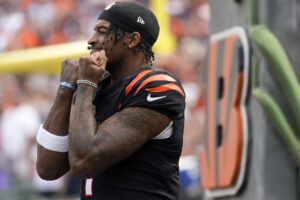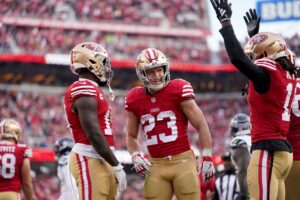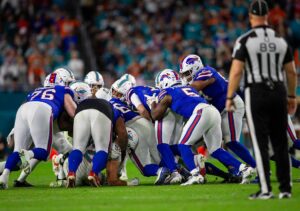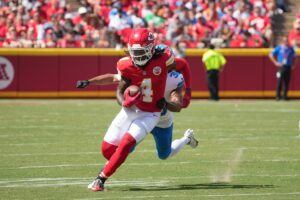In the world of sports, one topic that remains in discussional rotation is the idea of an athlete’s prime. Commonly referred to as “peak,” a player’s prime is a stretch during their career in which they’ve arrived at their athletic apex in both production and physique. Usually ranging from their mid-to-late twenties to early thirties, athletes’ greatest outputs are sandwiched in between their ascension stage and twilight stage. Numerous sports greats, however, have challenged “Father Time” and struck lightning in a bottle with post-pinnacle performances. In 2009, 40-year-old Brett Favre threw for 4,202 yards (third-most in career), 33 touchdowns (most since 1997) and only seven interceptions (fewest since his 1991 rookie season) for the Minnesota Vikings. Four years later, Denver Broncos signal-caller Peyton Manning composed the greatest quarterback campaign in NFL history with league records in passing yards (5,477) and scoring strikes (55) at age 37. Those, of course, were outlier occasions established by outlier players.
Another key element about primes involves the supporting cast around the peak athlete. As legendary as Favre and Manning were individually, they had respectable cores to supplement their success. Every player doesn’t have that luxury. While in the midst of their athletic superiority, the career peaks of many top-tier performers are tarnished because of subpar teammate assistance. This reality is especially prevalent with quarterbacks in football. Unlike basketball, which is a two-way sport that requires players to control the game on both ends of the floor, a field general can’t defend opposing offenses.
The NFL today features three quarterbacks who are asked to take a cumbersome load due to lack of requisite pieces on their respective rosters. Having these passing savants at their career best makes matter worse for their fanbases to watch these passers struggle to carry poor teams.
The Three Most Wasted Quarterback Primes
1. Andrew Luck
Entering the 2015 season, Andrew Luck’s career went as expected. Drafted number one overall in 2012, the Stanford star took a 2-14 Indianapolis Colts team to 11-5 his rookie year and continued to surge upward the next two seasons. Compiling 12,957 yards and 86 touchdowns for his first three campaigns, Luck led the Colts to the wild card, divisional playoff and AFC Championship rounds, respectively, in the 2012-2014 postseason runs. He accomplished these feats with post-peak players from the illustrious Bill Polian regime. With the exception of the 2012 draft, now-former general manager Ryan Grigson did a poor job of acquiring talent during his front office tenure in Indy. In fact, the only Pro Bowler drafted by the Colts besides Luck was wide receiver T.Y. Hilton, who shares the same draft class as the franchise player. Luck and Hilton are the only players remaining from that initial class, and none of the subsequent draftees have panned out to date.
Historically, premier quarterbacks have proven to mask the deficiencies at other positions on their teams especially at offensive line. Despite being ranked a middle-of-the-pack unit going into 2015, according to Pro Football Focus, analysts still had concerns about the line’s ability to protect Andrew Luck. Clearly in win-now mode after 2014, they should’ve addressed that area in free agency. Instead of pursuing Pro Bowl guard Evan Mathis, the front office opted to maintain the players they had in house. Luck ultimately got injured and was restricted to only seven starts in 2015. Indianapolis also had the opportunity to cash in on center Alex Mack last summer but let him sign with Atlanta. Mack’s presence helped engineer a Falcons Super Bowl berth while Andrew Luck was sacked 41 times and missed the playoffs for the second consecutive year. On the defensive side of the ball, defensive end Robert Mathis, linebacker D’Qwell Jackson and safety Mike Adams did make Pro Bowls under Andrew Luck’s leadership, but they were each in their thirties. Outside of that trio, cornerback Vontae Davis was the most reliable defender.
With new general manager Chris Ballard at the helm, hopefully Luck’s career fortunes will change.
2. Drew Brees
In terms of age, pundits would deem Drew Brees passed his prime, but he is still playing at a high level. In Week 6 of 2016, Brees surpassed Peyton Manning’s NFL record of 400-yard passing games with 15. The next week, he became the first player to obtain 100 games with 300-plus passing yards. By season’s end, Brees achieved his fifth 5,000-yard passing campaign, more than all other quarterbacks combined (four) in league history. Alike Tom Brady, Drew Brees has shown to expand his window of prime play. The former San Diego Charger has achieved these marks all without having a Pro Bowl wide receiver in his entire NFL career.
Notwithstanding the lack of skill position stars, the defense has been the largest impediment for the post-Hurricane Katrina New Orleans Saints. Since 2006, the New Orleans defense has placed 23rd or worse eight times. Even when the Saints won the 2009 Super Bowl, the unit finished 25th in total defense. In that 11-year span, their defense ranked in the top half of the league (1st-16th) only three seasons (2006: 11th, 2010: 4th and 2013: 4th). In his record-setting campaign of 2011, the best of his professional life, the defense only mustered up the 24th-best corps. The next season, the Saints became the statistically-worst defense in NFL history.
Failing to clinch postseason contention three years running, Drew Brees’ chances of returning to the mountaintop appear bleak.
3. Aaron Rodgers
Based on what transpired in last season’s NFC Championship game, Aaron Rodgers would be first on this list according to critics. After all, the Green Bay Packers defense hasn’t ranked higher than 11th since 2012. When Rodgers produced his greatest season in 2011 (career highs 4,643 yards, 45 touchdowns and 122.5 passer rating), Green Bay was dead last in defense. Although the unit finished top-15 in three of the following five campaigns, the defense fell apart in the playoffs. In the 2014 NFC title match, the Packers relinquished a 19-7 fourth-quarter lead to allow the home team Seattle Seahawks to clinch their second-consecutive Super Bowl berth. In the 2015 divisional playoff contest, Green Bay’s defense permitted a 75-yard completion from Carson Palmer to Larry Fitzgerald to set up the Arizona Cardinals’ game-winning score two plays later. After their 44-21 shellacking from the NFC Champion Falcons, the Packers defensive unit demonstrated yet again that it were a non-factor.
The Packers front office has become notorious for being too passive and not aggressively seeking free agents in the off-season. Besides, when Eddie Lacy is the only Pro Bowl rusher Rogers has benefited from, that’s an issue. Rodgers ranks third on this list for two reasons. One, regardless of its falters, he’s had better defensive cores than Luck and Brees. Secondly, the three Pro Bowl wide receivers he’s enjoyed (Greg Jennings, Jordy Nelson and Randall Cobb) are more than Luck or Brees ever had in their careers.
Main Photo:






